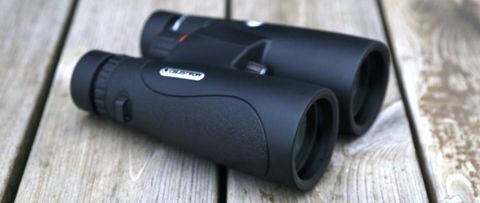If you’re after a pair of step-up binoculars designed for exquisite views while wildlife viewing and more, the Celestron Nature DX ED 12x50 could be for you. Armed with 12x magnification and 50mm objective lenses, the Celestron Nature DX ED 12x50 have a slightly higher magnification than most binoculars designed for all-round use, so they’re best considered if you want close-up views of distant subjects.
That makes them a serious candidate for viewing wildlife from a safari vehicle, and for bird-watching. However, what makes the Celestron Nature DX ED 12x50 standout is their use of top-notch extra-low dispersion (ED) glass. Let’s take a closer look at the Celestron Nature DX ED 12x50…
Celestron Nature DX ED 12x50 Specifications

Magnification: 12x
Objective diameter: 50mm
Field of view at 1000m: 129 m
Closest focusing distance: 2m/6.5 feet
Eye relief: 14.3mm/0.56"
Weight: 806g/28.4oz
Dimensions: 163 x 135 x 61mm / 6.4 x 5.3 x 2.4"
Celestron Nature DX ED 12x50 key features

The importance of the quality of glass used in the optical arrangements inside binoculars can’t be overstated. It’s basically what you’re paying for, and what the Celestron Nature DX ED 12x50 has that others lack is extra-low dispersion (ED) glass. It’s Celestron’s name for high quality glass that eliminates chromatic aberration (which is responsible for a purplish edge around bright objects), accurate color, more brightness and extra sharpness.
It goes without saying that the Celestron Nature DX ED 12x50 also features fully multi-coated optics to get rid of reflections and to maximize the light that comes through its 50mm objective lenses. Ditto the use of BaK-4 glass prisms, which allows more light through than the more basic BaK-7 glass prisms.
Celestron Nature DX ED 12x50 build & handling

The Celestron Nature DX ED 12x50 uses a roof prism design whose primary advantage is a space-efficient, more portable design. Essentially two tubes attached by a hinge (as opposed to the L-shaped optical engine between the tubes on a pair of porro prism binoculars), the Celestron Nature DX ED 12x50's tubes are nitrogen-purged to help reduce the threat of internal fogging.
The Celestron Nature DX ED 12x50 boasts an unbeatable build quality amid a highly portable design. Considering the magnification on offer the 806g/28.4oz weight is surprising. They’re not the lightest around, but we found them relatively easy to hold steady for long periods. In the box there’s a good quality neck strap and a small padded nylon bag complete with a handy pocket. There’s also a thread for attaching a L-shaped adaptor just in case you want to attach these binoculars to a tripod.
In an all-round impressive package, what the Celestron Nature DX ED 12x50 lacks is eye relief; at just 14.3mm/0.56in it’s going to be tough for anyone wearing glasses to get immersive views.
Celestron Nature DX ED 12x50 performance

Celestron’s ED glass comes in most useful during low-light conditions. Say, for instance, you’re getting up at 4 a.m. to go on a game drive in a safari truck hoping to view the ‘big five’ in the creeping light of dawn – that’s when ED glass comes into its own.
What the Celestron Nature DX ED 12x50 can also do – which some of its equally powerful rivals cannot – is to focus on close objects. While primarily ideal for bringing distant objects closer, these binoculars can focus sharply on objects just 2m/6.5 feet from the viewer, which makes a massive difference when viewing birds and wildlife in, say, your back garden.
The trade-off here is a slightly narrower field of view (of about 4.8°), which makes them slightly less than ideal for using at night to search star-fields and constellations in the night sky. However, in practice the Celestron Nature DX ED 12x50 performs really well at night, with the Andromeda galaxy looking sharp and well defined. Ditto the crescent Moon, which looked clean with no sign of purplish fringing – thanks to that ED glass.
Something we found slightly annoying was the objective lens caps, which are attached to the tubes and hang down while you use the Celestron Nature DX ED 12x50. That makes them hard to lose, which is a bonus. However, they do tend to flap around a lot, so they’re best removed if you’re using them for a long time.
Celestron Nature DX ED 12x50 verdict

The ability to get a close focus on nearby objects as well as a reasonably wide field of view makes the Celestron Nature DX ED 12x50 useful for a range of outdoor uses, as does the tough build quality and the ED glass, which gives excellent images that are bright, colorful and sharp. If you're after a mid-range pair of large binoculars ideal for wildlife viewing, the Celestron Nature DX ED 12x50 fit the bill.
Read more:
• The best binoculars
• Best budget binoculars under $100
• Best marine binoculars
• Best rangefinder binoculars
• Best compact binoculars
• Best opera glasses
• Best binocular harnesses
• Best binocular tripod adapter
• The 10 best spotting scopes
• The best night vision goggles
• The best opera glasses
• The best telescopes for astrophotography



